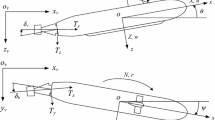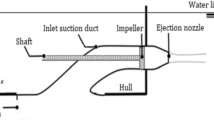Abstract
Thrust force is a very important factor for underwater vehicles. The thrust force that is determined by the pressure gradient between a propeller and a thruster can be represented by the ambient flow velocity introduced as the control volume and the axial flow velocity of a propeller. Because a change in ambient flow velocity triggers a change in the pressure gradient between a propeller and a thruster, a model taking account of the ambient flow velocity is required for an unmanned underwater vehicle (UUV) system. However, the axial flow velocity introduced into a propeller is very difficult to measure without accurate test devices. Therefore, in this study, the axial flow velocity is calculated with the computational fluid dynamics (CFD) method to use it as a basis for estimating the approximate value of the thrust force. As a result, a relatively accurate analysis of the effect of the ambient flow velocity on the thrust force can be obtained with considerable time and cost effectiveness as compared to the existing experimental methods. To evaluate the validity of the data from the CFD analysis results depending on the change in ambient flow velocity and the pressure gradient of a thruster, the resulting CFD values were compared with the thrust forces obtained in the previously performed thrust force experiment of a thruster depending on the ambient flow velocity in a circulating water channel.







Similar content being viewed by others
References
Kim Jinhyun, Chung Wan Kyun (2006) Accurate and practical thruster modeling for underwater vehicles. Ocean Eng 33:566–586
Lee Chong-Moo, Choi Hyun-Teak, Kim Kihun, Yeo Dong jin, Lee Pan-Mook (2011) The estimation of the thrust performance of a UUV using commercial thruster. J KSOE 24(6):27–31
Newman JN (1977) Marine hydrodynamics. MIT Press, Cambridge
Whitcomb LL, Yoerger DR (1999) Development, comparison, and preliminary experimental validation of nonlinear dynamic thruster models. IEEE J Oceanic Eng 24(4):481–494
Yoerger DR, Cooke JG, Slotine J-JE (1990) The influence of thruster dynamics on underwater vehicle behavior and their incorporation into control system design. IEEE J Oceanic Eng 15(3):167–178
Blanke M, Lindegaard K-P, Fossen TI (2000) Dynamic model for thrust generation of marine propellers. In: Proceedings of the IFAC conference maneuvering and control of marine craft (MCMC2000), pp 23–25
Bachmayer R, Whitcomb LL (2003) Adaptive parameter identification of an accurate nonlinear dynamical model for marine thrusters. J Dyn Sys Meas Control 125(3):491–494
Author information
Authors and Affiliations
Corresponding author
Additional information
The authors acknowledge the financial support of the project ‘Development of inspection equipment technology for harbor facilities’ funded by Korea Ministry of Oceans and Fisheries.
Rights and permissions
About this article
Cite this article
Chung, HK., Kim, J. Analysis of underwater thruster model with ambient flow velocity using CFD. Intel Serv Robotics 6, 163–168 (2013). https://doi.org/10.1007/s11370-013-0133-7
Received:
Accepted:
Published:
Issue Date:
DOI: https://doi.org/10.1007/s11370-013-0133-7




